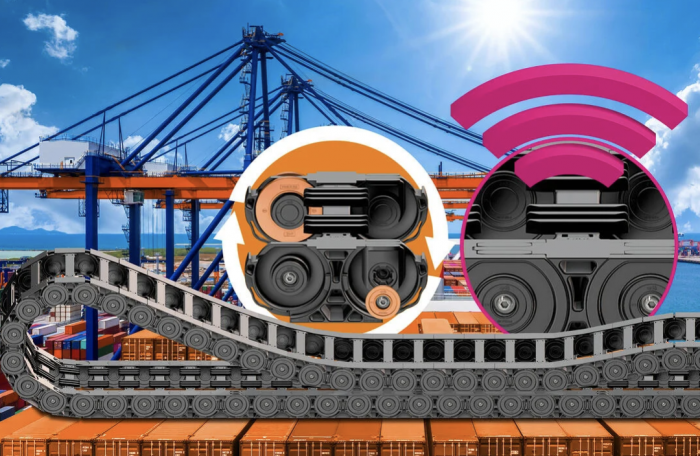STS container cranes: new heavy-duty roller chain from igus

Container cranes in the world’s ports will be even more powerful and fail-safe in the future. Because igus is launching P4HD.56.R – a new heavy-duty energy chain, prepared for long travels, high speeds, high cable loads and Industry 4.0.
If the belly gets fatter, new trousers are needed. Ports around the world are experiencing a similar situation. Modern container ships like the Ever Ace are 400 metres long, 62 metres wide and load almost 24,000 containers. The bigger pants in this case are a larger ship-to-shore (STS) crane that loads and unloads the containers. An enlargement that also affects the energy chains that carry the crane trolley’s energy and data cables on the crane bridge. They have to withstand unprecedented loads: Travel distances of over 130 metres, cable weights of up to 10kg/m or (in the case of motor-driven trolleys) over 20kg/m and accelerations of more than 1m/sec2 are standard for Triple-E-Class STS cranes.
In other applications, travel distances of several hundred metres, cable loads of up to 50kg/m and accelerations of 8m/sec2 and more are possible. “We have developed the new heavy-duty energy chain P4HD.56.R for these extreme requirements,” says Theo Diehl, industry manager for cranes at igus. “The energy chain is particularly robust and, thanks to sensor technology, prepared for Industry 4.0 trends such as predictive maintenance. A combination that significantly increases the reliability of STS cranes.”
Heavy-duty energy chain to run trouble-free for up to 15 years
To achieve a long service life in STS cranes under heavy loads, the engineers have come up with design tricks. “A special fork-link principle ensures even more stability at higher additional loads, a pin-bore connection made of tribologically optimised plastic ensures minimum wear,” Diehl explains. In addition, rollers are mounted in the inner radius of the chain links. When the e-chain folds, the upper run rolls on the lower run instead of sliding.
Thus, thanks to the low coefficient of friction, it is possible to increase payload and acceleration while maintaining the same push-pull force. Long-term tests in the igus in-house laboratory prove this: The heavy-duty version P4HD.56.R achieves a 50 percent longer service life compared to the normal version P41.56R. “Our goal is for the e-chain systems to run for up to 15 years on every STS crane – trouble-free and with minimal maintenance,” says Diehl. A nice side effect: the rolling motion reduces the required drive energy by 57 percent.
In times of rising energy prices, this is also a plus point. Since crane systems also require robust cables that can be used to realise long travels with high dynamics, igus also offers a chainflex cable range with CFCRANE that was specially developed for crane applications.
Fit for Industry 4.0
But the new P4HD.56.R is not only robust, durable and energy-saving. The heavy-duty energy chain is also Industry 4.0-capable. For example, it enables so-called predictive maintenance. With the help of the i.Sense monitoring sensors, the condition of the chain links can be continuously transmitted to the i.Cee:plus communication module. By using i.Cee, users can rely on usage- and condition-based maintenance and thus extend the intervals between individual inspection intervals.
Maintenance is only necessary when the system gives an appropriate signal. With the help of the i.Cee system, operators of STS cranes can significantly increase system availability and extend the service life of the energy chains. Operating holidays and other planned downtimes are automatically taken into account in the service life calculation by i.Cee and the forecast is constantly checked by means of sensors.
Advantages for which, by the way, the user does not have to accept any restrictions in the usable inner width. This is because the condition sensors and their electronics are integrated into the roller chain links to save space. Additional cables are not necessary, because the data transmission is done via radio. “The new e-chains of the P4HD.56.R series thus meet all the requirements that apply to STS cranes of the next generation and the one after that,” says Theo Diehl.
For more information, please visit: https://www.igus.de/
News Categories
- » NEWS HOME
- » Automation & Robotics
- » Industry 4.0
- » Material Handling
- » Sensors
- » Quality & Testing
- » Machine Vision
- » Laser & Optics
- » Metalworking
- » Motion Control & Drives
- » Hydraulics & Pneumatics
- » Process Industry
- » Renewable Energy
- » Agriculture
- » Home & Office Furniture
- » Environmental Tech



